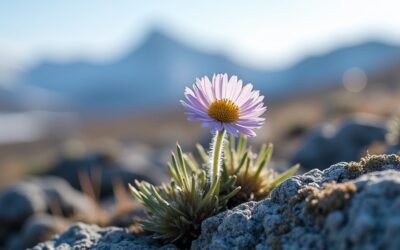Arctic Lungwort (Mertensia maritima) is a remarkable coastal plant adapted to harsh Arctic environments, distinguished by its thick, fleshy leaves and oyster-like flavor. The plant grows 6-12 inches tall, creating dense mats of silvery-blue foliage that shifts to deeper blue-green throughout the season. It's equipped with extraordinary cold-tolerance mechanisms, including antifreeze proteins that protect tissues at temperatures as low as -40°C. The plant produces vibrant blue-to-purple bell-shaped flowers from June through August, attracting Arctic bumblebees for pollination. This resilient species reveals fascinating survival strategies that showcase nature's innovative adaptations to extreme conditions.
INTRODUCTION
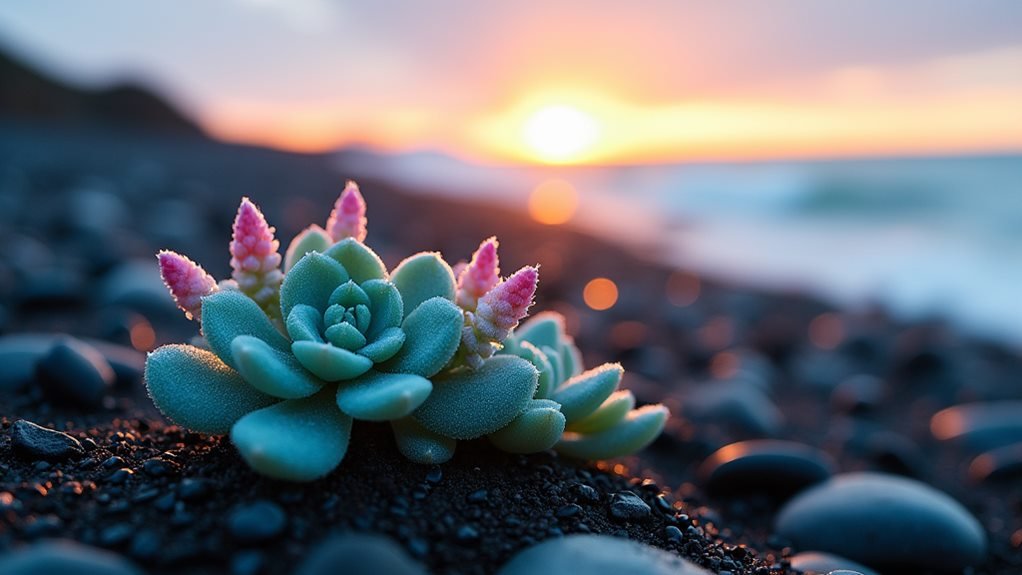
Arctic lungwort (Mertensia maritima) belongs to the borage family (Boraginaceae), which includes familiar garden plants like forget-me-nots and comfrey.
The distinctive plant, commonly known as oysterplant in some regions, earned its name from both its northern habitat and the historical belief that its leaves could treat lung ailments.
Its scientific classification places it among approximately 50 other Mertensia species, though it stands out as one of the few members adapted specifically to Arctic and subarctic coastal environments.
Common Name(s)
The plant known as Arctic lungwort commonly goes by several names including boreal lungwort, northern lungwort, and Arctic mertensia. In coastal communities, it's frequently called oysterleaf or oyster plant due to its distinctive oyster-like flavor, which has made it increasingly popular in Arctic culinary uses and modern Nordic cuisine.
Among indigenous peoples of the North, the plant carries various traditional names that reflect its medicinal properties and cultural significance. The Inuit refer to it as "sea lungwort" in their dialects, acknowledging its coastal habitat and therapeutic applications.
In Scotland, where the plant flourishes along rocky shores, locals have historically called it the "blue sea trumpet" due to its striking trumpet-shaped flowers.
The scientific community primarily uses Mertensia maritima, though the common name "Arctic lungwort" has become increasingly standardized in botanical literature and field guides. This standardization helps avoid confusion with other Mertensia species, particularly the Virginia bluebells (Mertensia virginica), which share some physical characteristics but prefer different growing conditions.
Scientific Name
Botanists classified Arctic lungwort under the scientific name Mertensia maritima (L.) Gray, placing it within the family Boraginaceae. The genus name Mertensia honors Franz Carl Mertens, an esteemed 19th-century German botanist who made significant contributions to the study of algae and vascular plants.
The species epithet "maritima" refers to the plant's natural coastal habitat, where it thrives in maritime environments along northern shorelines. In botanical classification systems, Mertensia maritima belongs to a genus comprising approximately 50 species, with this particular species displaying distinct adaptations to Arctic and subarctic conditions.
The "(L.)" in its name acknowledges Carl Linnaeus, who first described the species, while "Gray" refers to Asa Gray, who later revised its classification.
The scientific name encapsulates the plant's evolutionary history and ecological niche, serving as a universal identifier across botanical literature. This standardized naming system guarantees that researchers worldwide can accurately identify and study this remarkable coastal species, regardless of the various common names it might bear in different regions.
Family Classification
While Mertensia maritima's scientific name provides its specific identity, its family classification offers broader insights into its relationships with other plants. The Arctic lungwort belongs to the Boraginaceae family, also known as the borage or forget-me-not family, which includes approximately 2,000 species worldwide.
This familial placement reflects important phylogenetic relationships that connect the Arctic lungwort to other well-known plants like comfrey, borage, and forget-me-nots, all sharing distinctive characteristics such as hairy leaves and bell-shaped flowers.
The Boraginaceae family's genetic diversity has enabled its members to adapt to various environments, from coastal regions to alpine meadows, demonstrating remarkable evolutionary success across different habitats.
Within this family, Mertensia maritima belongs to the subfamily Boraginoideae, which encompasses plants that typically produce blue or purple flowers and exhibit specific DNA marker patterns.
Understanding the Arctic lungwort's family classification helps scientists trace its evolutionary history and assess its conservation needs, as related species often share similar environmental vulnerabilities and adaptive strategies.
This taxonomic framework also aids researchers in predicting potential medicinal properties based on shared family characteristics.
QUICK IDENTIFICATION GUIDE
The Arctic lungwort stands between 5-15 inches tall with a compact spread of 6-12 inches, displaying clusters of vibrant blue-to-purple flowers that emerge before its broad, rough-textured leaves fully develop.
A notable identifying feature is the plant's distinctive basal rosette of lance-shaped leaves, which are often marked with silvery-white spots and covered in fine, bristly hairs.
The plant's extensive fibrous root system penetrates deeply into arctic and alpine soils, anchoring it against harsh winds while enabling survival in nutrient-poor conditions through specialized nutrient absorption mechanisms.
Height/Spread
Arctic lungwort typically reaches heights of 6-12 inches (15-30 cm) with a similar spread at maturity. The plant's growth patterns exhibit remarkable adaptability to harsh arctic conditions, allowing it to maintain a compact, low-growing form that protects it from fierce polar winds.
Size variations among individual plants often depend on environmental factors, with those growing in more sheltered locations occasionally reaching heights of up to 15 inches (38 cm). The plant's spreading habit creates dense mats of foliage that can extend laterally up to 24 inches (61 cm) in ideal conditions, though they're typically more restrained in exposed coastal areas.
The plant's prostrate growth form serves as an evolutionary advantage, enabling it to trap heat close to the ground and create its own microclimate. Each stem grows horizontally before curving upward, rarely exceeding the characteristic height range of the species.
During the growing season, the plant maintains a relatively consistent size, though it may appear more compact during periods of environmental stress or extreme weather conditions, demonstrating its remarkable ability to adjust its growth habits to survive in challenging arctic environments.
Physical Characteristics
Identifying Arctic lungwort requires attention to several distinctive features. The plant's most notable characteristic is its striking leaf structure, which consists of thick, fleshy leaves arranged in a rosette pattern at the base.
These bluish-green leaves have a smooth, waxy surface that feels surprisingly cool to the touch, much like sea glass weathered by ocean waves.
The plant exhibits remarkable color variation throughout its growing cycle. Its leaves start with a silvery-blue hue in early spring, intensifying to a deeper blue-green as the season progresses.
The flowers emerge in nodding clusters, shifting from pink buds to brilliant blue bell-shaped blooms, each measuring approximately 1 centimeter in length. These delicate blossoms feature five fused petals forming a short tube with a flared opening.
The plant's stems are typically succulent and slightly transparent, carrying an alternating pattern of oval to elliptical leaves that measure 2-7 centimeters in length.
The entire plant is covered in a glaucous coating that gives it a distinctly frosted appearance, perfectly adapted to its harsh Arctic environment.
Root System
Beneath its delicate surface features, Arctic lungwort develops a robust root system that's essential for quick field identification. The plant establishes a deep-reaching taproot structure that typically extends 30-45 centimeters into sandy or gravelly coastal soils, anchoring it firmly against harsh Arctic winds.
The root system's most distinctive characteristic is its extensive network of lateral roots, which spread horizontally up to 60 centimeters from the central taproot. These secondary roots, resembling a web of fine underwater tendrils, are specialized for efficient nutrient absorption in nutrient-poor maritime environments.
The plant's root structure includes specialized root hairs that increase the surface area for mineral uptake by nearly 400 percent compared to similar coastal species.
During the brief Arctic growing season, the roots demonstrate remarkable adaptability by developing cork-like tissue layers that protect against salt exposure and temperature fluctuations. This adaptive root system enables the plant to thrive in challenging coastal conditions, where soil composition can shift dramatically with tidal influences and seasonal changes.
The roots also form beneficial associations with soil fungi, enhancing their nutrient-gathering capabilities.
Visual Identifying Features
Three key features make Arctic lungwort instantly recognizable in the field: its silvery-blue hairy leaves, clusters of nodding blue-purple flowers, and compact growth habit rarely exceeding 20 centimeters in height.
The plant's distinctive leaf color results from a dense coating of fine, waxy hairs that protect against harsh coastal conditions while giving the foliage an almost metallic sheen. Its growth patterns follow a prostrate to semi-erect form, with stems often sprawling along the ground in response to strong winds in its preferred habitat of coastal gravel and sand dunes.
The flowers, which emerge in late spring, evolve from pink buds to striking blue-purple blooms, making the plant particularly attractive to bumblebees and other pollinators.
This species demonstrates remarkable climate resilience through its ability to thrive in nutrient-poor soil conditions, where its extensive root system helps stabilize loose substrate.
While historically valued for medicinal uses, particularly in treating respiratory ailments, its primary ecological roles today include dune stabilization and providing essential nectar resources for arctic pollinators.
HABITAT & GROWTH
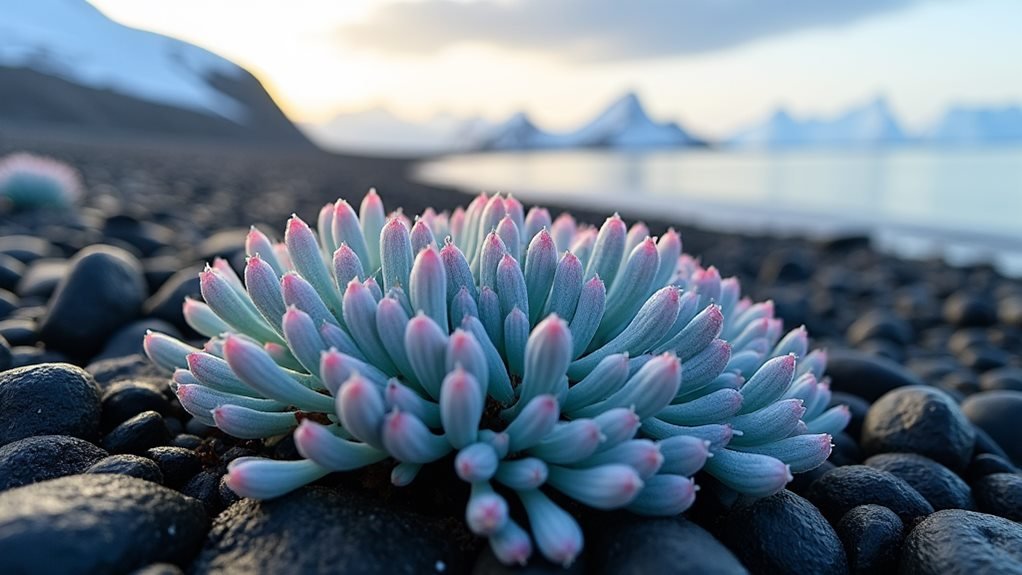
Arctic lungwort thrives across the circumpolar regions of North America, Europe, and Asia, where it has adapted to survive in harsh tundra environments and rocky alpine meadows.
The plant's growing season runs briefly from late spring through early summer, coinciding with the fleeting arctic warm period when temperatures hover between 5-15°C (41-59°F).
These hardy perennials flourish in well-draining, slightly acidic soils with pH levels between 5.5 and 6.5, often establishing themselves in protected microsites where snow accumulation provides essential winter insulation.
Natural Distribution
The native range of Arctic lungwort extends throughout the high-altitude regions of Alaska, northern Canada, and Greenland, where it thrives in rocky tundra and alpine meadows. Its geographical range follows a circumpolar distribution pattern, stretching across the Northern Hemisphere's coastal areas and reaching as far south as the northern British Isles.
This hardy plant has adapted to specific habitat preferences, flourishing in gravelly beaches, shingle shores, and maritime cliffs where few other species can survive. In Scandinavia, it's commonly found along the Norwegian coastline, while substantial populations exist throughout Iceland's rugged terrain.
The species has also established itself in scattered locations across Russia's northern territories, particularly in areas where coastal conditions meet its precise growing requirements.
Recent climate changes have begun to influence its distribution patterns, with some populations showing slight northward shifts in their traditional ranges. Despite these changes, Arctic lungwort maintains strong presence in its core habitats, demonstrating remarkable resilience in the face of environmental pressures through its ability to colonize new suitable areas along the Arctic coast.
Growing Season
Living in extreme northern environments shapes Arctic lungwort's distinct growing season. The plant has adapted to thrive during the brief Arctic summer, typically emerging from dormancy in late May when temperatures consistently rise above freezing.
Its growing techniques have evolved to maximize productivity during the short window of favorable conditions.
During the peak growing period from June through August, Arctic lungwort develops rapidly, producing its characteristic bluish-green foliage and clusters of blue flowers.
The plant faces significant seasonal challenges, including intense 24-hour sunlight, strong winds, and occasionally unstable soil conditions along coastal areas.
To combat these environmental pressures, it maintains a low-growing profile and develops a robust root system.
Growing Conditions
Natural habitats of Arctic lungwort span across tundra regions, rocky slopes, and coastal areas where well-drained soils prevail. This resilient plant thrives in soil requirements that mirror its native environment, preferring gravelly or sandy substrates with excellent drainage capabilities.
The plant's moisture levels must be carefully balanced, as it tolerates moderate drought but can't withstand waterlogged conditions that might lead to root rot.
Temperature preferences align with its Arctic nature, flourishing in cool climates where summer temperatures rarely exceed 70°F (21°C).
With regard to light exposure, Arctic lungwort adapts remarkably well to both full sun and partial shade conditions, though coastal specimens often demonstrate better growth in full sunlight.
The plant's nutrient needs are relatively modest, requiring only minimal fertilization in soil with a slightly alkaline pH balance ranging from 7.2 to 7.8.
While pest management isn't typically a major concern, occasional monitoring for slugs and snails is advisable.
For companion planting, Arctic lungwort coordinates well with other coastal species like sea thrift and beach pea, creating natural-looking plant communities that echo their wild habitat associations.
ARCTIC ADAPTATIONS
Arctic lungwort showcases remarkable cold tolerance mechanisms, including specialized cell membranes that remain flexible at subzero temperatures and antifreeze proteins that prevent ice crystal formation.
The plant has synchronized its growth and reproductive cycles with the extreme Arctic photoperiod, efficiently utilizing the continuous summer daylight while entering dormancy during the dark winter months.
Its extensive root system penetrates the active layer of permafrost, allowing the plant to anchor securely and access water resources when the topsoil temporarily thaws during brief growing seasons.
Cold Tolerance Mechanisms
Through millions of years of evolution, Arctic lungwort has developed remarkable cold tolerance mechanisms that allow it to thrive in extreme polar conditions. The plant's sophisticated cryoprotection mechanisms include the production of specialized proteins and sugars that prevent ice crystal formation within its cells.
When temperatures plummet below freezing, Arctic lungwort initiates a complex stress response that triggers the accumulation of antifreeze compounds in its tissues. These natural cryoprotectants work like biological antifreeze, lowering the freezing point of cellular fluids and protecting essential organelles from damage.
The plant's cell membranes have also adapted to become more flexible at low temperatures, allowing them to bend rather than break when ice forms in intercellular spaces. This remarkable plasticity is enhanced by elevated levels of unsaturated fatty acids, which maintain membrane fluidity even when temperatures drop to -40°C.
Additionally, Arctic lungwort can rapidly activate dormant genes that code for cold-shock proteins, providing an extra layer of protection against sudden temperature fluctuations. These proteins act like molecular chaperones, preventing other proteins from misfolding or aggregating under cold stress.
Light Response (24-hour cycles)
Beyond its remarkable cold tolerance features, Arctic lungwort has evolved sophisticated mechanisms to handle the extreme light conditions of polar regions. The plant maintains impressive photosynthetic efficiency despite experiencing dramatic seasonal variations in solar exposure, from 24 hours of daylight in summer to complete darkness in winter.
The species' circadian rhythms have adapted to function effectively during extended periods of light or dark, regulating growth patterns through a complex network of photoreceptors and hormonal signals. During the midnight sun period, Arctic lungwort adjusts its light intensity tolerance, enabling photosynthesis even when solar radiation remains constant for weeks.
The plant's leaves can modulate their chlorophyll content and orientation throughout the 24-hour cycle, much like a living solar panel optimizing its position. These adaptations allow Arctic lungwort to maximize its growing season during the brief Arctic summer, when continuous daylight drives accelerated development.
The plant's remarkable ability to synchronize its metabolic processes with polar light conditions demonstrates nature's capacity to fine-tune survival strategies in extreme environments.
Permafrost Survival Strategies
Surviving in permafrost conditions demands extraordinary physiological adaptations from Arctic lungwort. The plant has developed remarkable permafrost resilience through specialized cellular mechanisms that protect its tissues from ice crystal formation during extreme temperature fluctuations.
During winter months, Arctic lungwort employs a sophisticated frost tolerance system that includes the production of antifreeze proteins and elevated sugar concentrations within its cells. These compounds lower the freezing point of cellular fluid, preventing destructive ice crystal formation when temperatures plummet to -40°C or below.
The plant's root system demonstrates equally impressive adaptations, developing specialized contractile roots that can adjust their position within the soil as permafrost layers shift. This remarkable ability allows the plant to maintain ideal depth despite seasonal frost heave movements of up to 10 centimeters.
The lungwort's vascular tissue contains unique elastic cell walls that can withstand repeated freeze-thaw cycles without rupturing. Like a flexible rubber hose that doesn't crack in winter, these adaptable tissues guarantee continued water and nutrient transport even when surrounding soil temperatures fluctuate dramatically between seasons.
REPRODUCTION
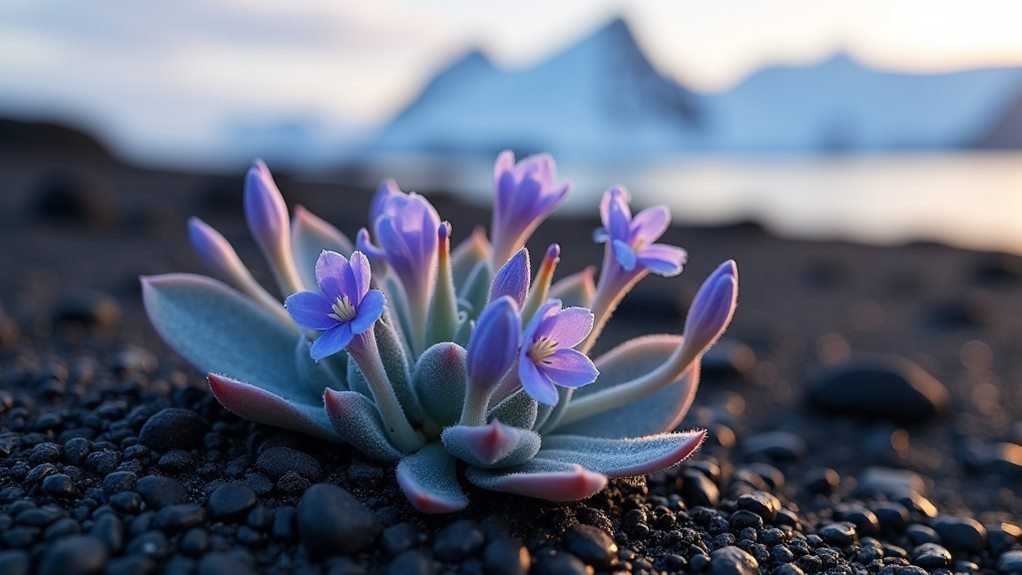
The Arctic lungwort begins its reproductive cycle during the brief summer window, typically flowering between late June and early August when temperatures rise above freezing.
Through a combination of self-pollination and assistance from resilient Arctic bumblebees, these hardy perennials guarantee successful reproduction even in harsh polar conditions where pollinators are scarce.
The plant's tiny seeds, which develop in protective capsules, are eventually scattered by strong Arctic winds across the tundra, where they remain dormant through winter before beginning their growth cycle anew during the next growing season.
Flowering Period
During its reproductive cycle, Arctic lungwort typically flowers from late June through August, producing delicate purple-blue blooms that emerge shortly after snowmelt. Key flowering triggers include increasing day length and soil temperatures reaching above 5°C (41°F), though seasonal variations can shift these timelines by several weeks in different Arctic regions.
The flowering period's duration depends greatly on local environmental conditions, with plants in more sheltered locations often blooming for up to six weeks. In exposed coastal areas, where the species frequently grows, the flowering window may be compressed to just three or four weeks.
The plant's remarkable ability to synchronize its flowering with the brief Arctic summer guarantees maximum pollinator activity, particularly from bumblebees and hover flies. During peak bloom, each plant can produce 15-25 flower clusters, with individual blossoms lasting 4-7 days.
The flowers change from pink buds to their characteristic blue hue as they mature, creating a striking display against the plant's silvery-blue foliage. This color change serves as a visual signal to pollinators, indicating when flowers are ready for pollination.
Pollination Method
Arctic lungwort relies primarily on insect pollination, with bumblebees serving as its most effective pollinators in the harsh Arctic environment. The plant's vibrant blue-purple flowers, which shift from pink to blue during maturation, are particularly attractive to these industrious pollinators. Specialized flower structures, including a narrow corolla tube and positioned anthers, have evolved to accommodate bumblebees' unique pollination capabilities.
While bees pollination remains the dominant method, the plant has developed a secondary strategy of wind pollination as an adaptation to the Arctic's unpredictable conditions. During periods when insect activity is limited due to severe weather, the plant's exposed stamens allow pollen to be carried by strong Arctic winds to nearby flowers.
This dual-pollination strategy greatly increases the species' reproductive success rate in its challenging habitat. The effectiveness of wind pollination is enhanced by the plant's tendency to grow in dense clusters, which facilitates pollen transfer between neighboring plants.
Studies have shown that successful pollination occurs approximately 65% through insect vectors and 35% through wind dispersal, demonstrating the plant's remarkable adaptive capabilities.
Seed Dispersal
Once mature flowers have been successfully pollinated, Arctic lungwort produces small nutlets that contain its seeds. These nutlets develop into dark brown, oval-shaped structures measuring approximately 4-5 millimeters in length, with a slightly rough exterior that aids in their dispersal.
The plant employs multiple dispersal mechanisms to guarantee successful seed distribution across its Arctic habitat. Wind serves as the primary dispersal agent, carrying the lightweight nutlets across the coastal areas where the species typically grows.
During winter months, the frozen ground and snow create ideal conditions for secondary dispersal, as seeds can glide across icy surfaces and travel considerable distances.
Water also plays an essential role in seed dispersal, as Arctic lungwort's coastal habitat experiences regular tidal movements. The nutlets demonstrate remarkable seed viability, remaining capable of germination even after prolonged exposure to saltwater.
This adaptation allows the plant to colonize new coastal areas and maintain genetic diversity across populations. The seeds can remain dormant in the soil for several seasons until environmental conditions become favorable for germination.
Lifecycle Stages
The reproductive journey of Arctic lungwort begins in early spring when temperatures rise above freezing. The plant emerges from its winter dormancy as the snowpack recedes, initiating the first of its critical developmental phases.
Within weeks, the distinctive blue-green foliage unfurls, preparing the plant for its upcoming flowering stage.
As summer approaches, the plant progresses through its lifecycle stages with remarkable precision. Small flower buds develop in clusters, evolving from pink to striking blue as they mature.
The blooming period typically lasts 4-6 weeks, during which individual flowers advance through distinct maturation phases, opening sequentially rather than simultaneously.
Once fertilized, the flowers transform into nutlets, each containing a single seed.
ECOLOGICAL SIGNIFICANCE
Arctic lungwort serves as a crucial component in the Arctic food web, providing sustenance for various herbivorous insects and small mammals throughout the growing season.
The plant's early spring flowers offer essential nectar and pollen resources for native bees and other pollinators when few other flowering plants are available in the tundra ecosystem.
Its presence helps stabilize sensitive Arctic soils through its root system, while also creating microhabitats that support smaller organisms and contribute to the region's biodiversity.
Role in Food Web
Lungwort's ecological role in Arctic food webs extends primarily through its interactions with pollinators and herbivores. The plant serves as a vital early-season nectar source for bumblebees and other native pollinators, establishing important trophic interactions in the fragile Arctic ecosystem.
Through its extensive root system, it also participates in nutrient cycling by stabilizing coastal soils and facilitating nitrogen exchange.
Various herbivores, including Arctic hares and ptarmigan, feed on the plant's succulent leaves, which contain high levels of vitamin C and mineral content. These dietary relationships create essential energy transfer pathways in the coastal Arctic environment.
The plant's presence supports approximately 15-20 different pollinator species during its flowering period, which typically spans 4-6 weeks in summer months. When lungwort populations decline, researchers have observed corresponding decreases in local pollinator diversity.
The plant's role extends beyond direct consumption, as its decomposing matter enriches soil communities and supports microorganism populations.
Like a living bridge between marine and terrestrial ecosystems, lungwort facilitates nutrient exchange across these distinct environmental boundaries.
Wildlife Dependencies
Many wildlife species depend heavily on Arctic lungwort for both sustenance and habitat throughout their life cycles. The plant's distinctive blue-green foliage and clusters of bell-shaped flowers serve as essential microhabitats for various Arctic insects, particularly during the brief summer months when resources are scarce.
Arctic bumblebees and other native pollinators rely extensively on the lungwort's nectar-rich blooms, which helps maintain vital wildlife interactions within the tundra ecosystem. Small mammals, including Arctic voles and lemmings, seek shelter among the plant's low-growing leaves while feeding on its nutritious foliage, especially during the challenging shift periods between seasons.
These wildlife dependencies create an intricate web of relationships that contribute markedly to the region's ecosystem balance. Research has shown that areas with abundant Arctic lungwort populations support 30% more pollinator diversity compared to similar habitats without the plant.
The species acts as a cornerstone organism in Arctic coastal environments, where its presence helps stabilize fragile plant-animal relationships that have evolved over thousands of years in response to extreme environmental conditions.
Environmental Importance
Beyond its role in supporting wildlife, the ecological significance of Arctic lungwort extends deep into tundra ecosystem functions. The plant serves as an essential soil stabilizer in coastal regions, where its extensive root system helps prevent erosion of fragile Arctic shorelines and dunes.
As climate change continues to impact polar regions, Arctic lungwort has emerged as an important indicator species, reflecting shifts in temperature and seasonal patterns through its flowering times and distribution changes. The plant's ability to colonize disturbed areas makes it particularly valuable for habitat restoration projects in damaged coastal environments, where it acts as a pioneer species that paves the way for other vegetation to establish.
The species also plays an important role in nutrient cycling within Arctic ecosystems, as its decomposing leaves release essential minerals back into the typically nutrient-poor tundra soils. Its presence can alter soil chemistry through selective ion uptake, creating microhabitats that support diverse microbial communities and enhance overall ecosystem resilience.
The plant's salt-tolerant nature makes it especially significant in maintaining coastal biodiversity as sea levels rise and storm patterns intensify.
HUMAN CONNECTIONS
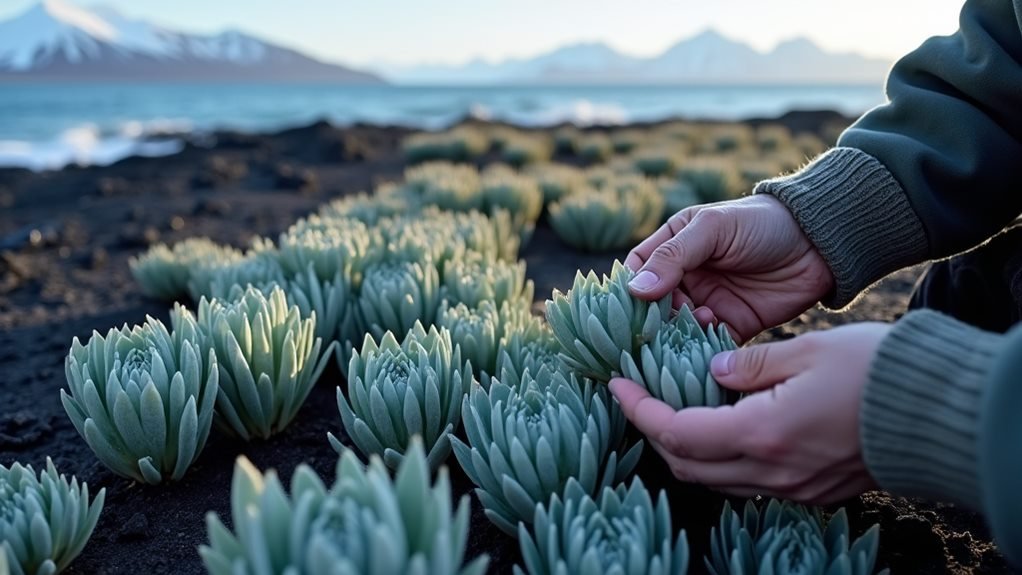
Arctic lungwort has played a significant role in indigenous Arctic communities, where it's been used traditionally as both a medicinal herb and ceremonial plant.
Modern scientific research has explored the plant's bioactive compounds for potential pharmaceutical applications, particularly in treating respiratory conditions and inflammatory disorders.
Despite its cultural and scientific value, Arctic lungwort faces mounting pressure from climate change and habitat disruption, leading to increased conservation efforts in several circumpolar regions.
Cultural & Traditional Significance
Traditional healers and indigenous peoples across the northern regions have long valued lungwort's medicinal properties and cultural significance. The plant's distinct blue-green leaves and color-changing flowers have been woven into cultural beliefs about natural cycles and seasonal changes in several Arctic communities.
In many coastal regions, traditional uses of Arctic lungwort extend beyond its medicinal applications to include food preservation and ceremonial practices. Indigenous communities have historically used the plant's leaves as a natural refrigerant for storing fish and meat, while its flowers have served as indicators for timing fishing activities.
The plant's connection to both land and sea has made it a symbol of environmental harmony in numerous northern cultures. Maritime communities have passed down knowledge about the plant's ability to survive in harsh coastal conditions, viewing it as a metaphor for resilience and adaptation.
This cultural understanding has contributed to sustainable harvesting practices, where communities collect only what's needed while ensuring the plant's continued presence in their ancestral territories. Modern ethnobotanists are now documenting these traditional practices to preserve this valuable cultural heritage.
Modern Applications
Contemporary researchers have discovered new applications for Arctic lungwort that bridge ancient wisdom with modern science. Recent studies have revealed significant health benefits in the plant's leaves and flowers, particularly their high omega-3 fatty acid content and antioxidant properties.
The culinary world has embraced Arctic lungwort's distinctive oyster-like flavor, with innovative chefs incorporating it into high-end gastronomy and sustainable food initiatives. Scientists have documented the plant's medicinal properties, including its potential for treating respiratory conditions and reducing inflammation through its unique compounds.
Ecological applications have emerged as researchers study the plant's ability to thrive in harsh coastal environments, making it valuable for shoreline restoration projects and climate change adaptation studies. The species' remarkable cold-hardiness mechanisms have inspired new approaches in agricultural research, particularly in developing frost-resistant crops.
Sustainable practices in harvesting and cultivation have become paramount, with specialized nurseries now propagating Arctic lungwort for both conservation and commercial purposes.
Research advancements continue to reveal promising applications in pharmaceuticals, while modern extraction techniques have improved the efficiency of isolating its beneficial compounds.
Conservation Status
Numerous indigenous communities have long recognized Arctic lungwort's cultural significance, leading to heightened conservation efforts in recent decades. Scientists and local authorities have collaborated to implement extensive conservation strategies that protect this valuable coastal species from environmental pressures and human activities.
The plant's specialized habitat requirements make it particularly vulnerable to climate change and coastal development. Several Nordic countries have established protected zones along their shorelines, creating safe havens where Arctic lungwort can thrive undisturbed.
These habitat protection measures include restrictions on beach development and careful monitoring of population dynamics, especially in areas where the species faces declining numbers.
Conservation efforts have shown promising results, with stable populations reported in protected areas across Norway, Iceland, and Scotland. However, challenges remain in regions where rising sea levels threaten the plant's preferred gravel beach habitats.
Researchers continue to study the species' resilience and adaptation capabilities, while working with coastal communities to develop sustainable management practices that balance human activities with the preservation of this culturally significant plant species.
Do Arctic Terns Depend on Arctic Lungwort as Part of Their Habitat or Diet?
Arctic terns are known for their remarkable migration patterns but don’t rely on Arctic lungwort for their diet or habitat. Instead, they primarily feed on fish and small marine creatures. One of the most fascinating facts about arctic terns is their ability to navigate across vast distances, migrating from the Arctic to the Antarctic annually.
How Do the Growth Habits of Arctic Cinquefoil Compare to Those of Arctic Lungwort?
Arctic cinquefoil plant grows low to the ground, spreading horizontally to conserve energy in harsh environments. In contrast, Arctic lungwort tends to grow more upright with broader leaves, maximizing sunlight capture. Both adapt uniquely to the cold, but the cinquefoil’s growth helps it survive winds and extreme temperatures better.
DID YOU KNOW?
Did you know that Arctic lungwort's leaves turn intensely blue when crushed? This remarkable color change occurs due to specialized pigment compounds called anthocyanins, which also contribute to the plant's medicinal uses in traditional Arctic communities.
The plant's unique properties have made it valuable for both healing practices and culinary applications.
In coastal communities across the northern hemisphere, Arctic lungwort has earned the nickname "oyster plant" because its leaves possess a distinctive briny flavor that remarkably mimics the taste of fresh oysters.
The plant's succulent leaves contain high levels of vitamin C and iodine, making them particularly nutritious for Arctic populations with limited access to fresh vegetables.
What's particularly fascinating is that Arctic lungwort can tolerate salt concentrations that would kill most other plants, thanks to specialized adaptations in its cell membranes.
These same adaptations allow it to survive in temperatures as low as -40°C (-40°F) by preventing ice crystals from forming within its tissues, a remarkable feat of natural engineering that's caught the attention of biotechnology researchers studying cold-resistance mechanisms.


